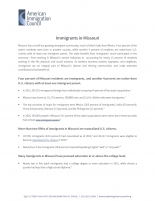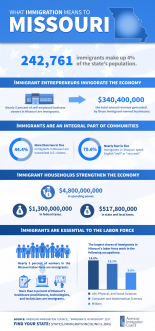- Fact Sheet
Immigrants in Missouri
Published
Missouri has a small but growing immigrant population, much of which hails from Mexico. Four percent of the state’s residents were born in another country, while another four percent of residents are native-born U.S. citizens with at least one immigrant parent. The state benefits from immigrants’ active participation in the economy—from working in Missouri’s service industries to accounting for 25 percent of residents working in the life, physical, and social sciences. As neighbors, business owners, taxpayers, and workers, immigrants are an integral part of Missouri’s diverse and thriving communities and make extensive contributions that benefit all.
Four percent of Missouri residents are immigrants, while another 4 percent of residents are native-born U.S. citizens with at least one immigrant parent.
- In 2018, 258,390 immigrants (foreign-born individuals) comprised 4 percent of the population.
- Missouri was home to 122,742 women, 111,553 men, and 24,095 children who were immigrants.
- The top countries of origin for immigrants were Mexico (15 percent of immigrants), China (8 percent), India (7 percent), Vietnam (5 percent), and Bosnia and Herzegovina (4 percent).
- In 2018, 223,079 people in Missouri (4 percent of the state’s population) were native-born Americans who had at least one immigrant parent.
Nearly half of all immigrants in Missouri are naturalized U.S. citizens.
- 127,336 immigrants (49 percent) had naturalized as of 2018, and 40,787 immigrants were eligible to become naturalized U.S. citizens in 2017.
- More than four in five (84 percent) immigrants reported speaking English “well” or “very well.”
Immigrants in Missouri tend to be college educated.
- Three in seven (44 percent) adult immigrants had a college degree or more education in 2018, while about one in six (17 percent) had less than a high school diploma.
|
Education Level |
Share (%) of All Immigrants |
Share (%) of All Natives |
|---|---|---|
|
College degree or more |
44 |
29 |
|
Some college |
21 |
31 |
|
High school diploma only |
18 |
31 |
|
Less than a high school diploma |
17 |
9 |
|
Source: U.S. Census Bureau, 2018 American Community Survey 1-Year Estimates. |
||
Nearly 35,000 U.S. citizens in Missouri live with at least one family member who is undocumented.
- 60,000 undocumented immigrants comprised 23 percent of the immigrant population and 1 percent of the total state population in 2016.
- 74,551 people in Missouri, including 34,546 U.S. citizens, lived with at least one undocumented family member between 2010 and 2014.
- During the same period, about 2 percent of children in the state were U.S. citizens living with at least one undocumented family member (26,614 children in total).
Missouri is home to over 3,000 Deferred Action for Childhood Arrivals (DACA) recipients.
- 3,010 active DACA recipients lived in Missouri as of March 2020, while DACA has been granted to 3,748 people in total since 2012.
- As of 2019, 49 percent of DACA-eligible immigrants in Missouri had applied for DACA.
- An additional 2,000 residents of the state would satisfy all but the educational requirements for DACA, and fewer than one thousand would become eligible as they grew older.
Immigrants make up 5 percent of the labor force in Missouri and are important in a range of industries.
- 164,394 immigrant workers comprised 5 percent of the labor force in 2018.
- Immigrant workers were most numerous in the following industries:
|
Industry |
Number of Immigrant Workers |
|
Manufacturing |
31,399 |
|
Health Care and Social Assistance |
24,605 |
|
Accommodation and Food Services |
19,363 |
|
Educational Services |
18,873 |
|
Professional, Scientific, and Technical Services |
15,545 |
|
Source: Analysis of the U.S. Census Bureau’s 2018 American Community Survey 1-year PUMS data by the American Immigration Council. |
|
- The largest shares of immigrant workers were in the following industries:
|
Industry |
Immigrant Share (%) |
|---|---|
|
Manufacturing |
8 |
|
Professional, Scientific, and Technical Services |
7 |
|
Accommodation and Food Services |
7 |
|
Arts, Entertainment, and Recreation |
6 |
|
Management of Companies and Enterprises |
6 |
|
Source: Analysis of the U.S. Census Bureau’s 2018 American Community Survey 1-year PUMS data by the American Immigration Council. |
|
Immigrants are an integral part of the Missouri workforce in a range of occupations.
- In 2018, immigrant workers were most numerous in the following occupation groups:
|
Occupation Category |
Number of Immigrant Workers |
|
Production |
21,862 |
|
Management |
15,697 |
|
Food Preparation and Serving Related |
15,550 |
|
Healthcare Practitioners and Technical |
14,157 |
|
Educational Instruction and Library |
12,521 |
|
Source: Analysis of the U.S. Census Bureau’s 2018 American Community Survey 1-year PUMS data by the American Immigration Council. |
|
- The largest shares of immigrant workers were in the following occupation groups:
|
Occupation Category |
Immigrant Share (%) |
|---|---|
|
Life, Physical, and Social Science |
25 |
|
Computer and Mathematical |
11 |
|
Production |
9 |
|
Building and Grounds Cleaning & Maintenance |
8 |
|
Arts, Design, Entertainment, Sports, and Media |
7 |
|
Source: Analysis of the U.S. Census Bureau’s 2018 American Community Survey 1-year PUMS data by the American Immigration Council. |
|
- Undocumented immigrants comprised 2 percent of Missouri’s workforce in 2016.
Immigrants in Missouri have contributed billions of dollars in taxes.
- Immigrant-led households in the state paid $1.9 billion in federal taxes and $790.8 million in state and local taxes in 2018.
- Undocumented immigrants in Missouri paid an estimated $107.1 million in federal taxes and $62.3 million in state and local taxes in 2018.
- Missouri DACA recipients and DACA-eligible individuals paid an estimated $7.4 million in state and local taxes in 2018.
As consumers, immigrants add billions of dollars to Missouri’s economy.
- Missouri residents in immigrant-led households had $6.8 billion in spending power (after-tax income) in 2018.
Immigrant entrepreneurs in Missouri generate hundreds of millions of dollars in business revenue.
- 14,795 immigrant business owners accounted for 5 percent of all self-employed Missouri residents in 2018 and generated $397.7 million in business income.
- In 2018, immigrants accounted for 14 percent of business owners in Kansas City (which spans Kansas and Missouri) and 3 percent of business owners in the St. Louis metropolitan area (which extends from Missouri into Illinois).
Help us fight for immigration justice!
The research is clear – immigrants are more likely to win their cases with a lawyer by their side. But very few can get attorneys.
Introducing the Immigration Justice Campaign Access Fund.
Your support sends attorneys, provides interpreters, and delivers justice.

Immigration Justice Campaign is an initiative of American Immigration Council and American Immigration Lawyers Association. The mission is to increase free legal services for immigrants navigating our complicated immigration system and leverage the voices and experiences of those most directly impacted by our country’s immigration policies to inform legal and advocacy strategies. We bring together a broad network of volunteers who provide legal assistance and advocate for due process for immigrants with a humane approach that includes universal legal representation and other community-based support for individuals during their immigration cases.


